Along with entertainment and healthcare, educational software development gains popularity among entrepreneurs the fastest. The global pandemic has ramped this process up. So even the most hesitant educational businesses no longer disregard what the IT industry offers and aim to create an educational app that will boost brand recognition and profit.
Online schools, courses, and multimedia educational tools have successfully made their way into our PCs and smartphones. And this trend will be on the rise for a long time. Consequently, there’s a demand for educational app development among businesses of all sizes.
In the following editorial Light IT Global will not only give you a brief analysis of the global eLearning market but also break down the development process, covering all of its aspects. So, if that’s something you’re interested in, read it to the very end.
What are educational apps?
An educational app is a piece of software that aims to help the user with distance learning and provide the means to study online. Its main goal is to facilitate the process of obtaining new skills and knowledge for the student regardless of their age, location, and condition.
When hearing about eLearning apps, some may assume that this term includes solely mobile applications. That’s not the case. Some of the most successful educational applications on the modern market are either web-based or have both web and mobile versions.
Take Google Classroom as an example. It’s an immensely popular interactive educational app that is web-based. It is also available on mobile devices, yet the web version is praised by teachers for its functionality, capacity, and ease of use.
Granting people around the world access to educational services, the apps that serve the purpose come in all shapes and forms. There are many types of software you can consider opting for. Let’s examine those more closely.
Most common types of educational apps
First of all, it’s necessary to clarify that there’s no standard typology when it comes to educational app development. Different sources may offer you different takes on the topic and mention different types of applications. The one we’re offering consists of the most common and profitable kinds of software you should familiarize yourself with if you want to create an educational app that won’t flop.
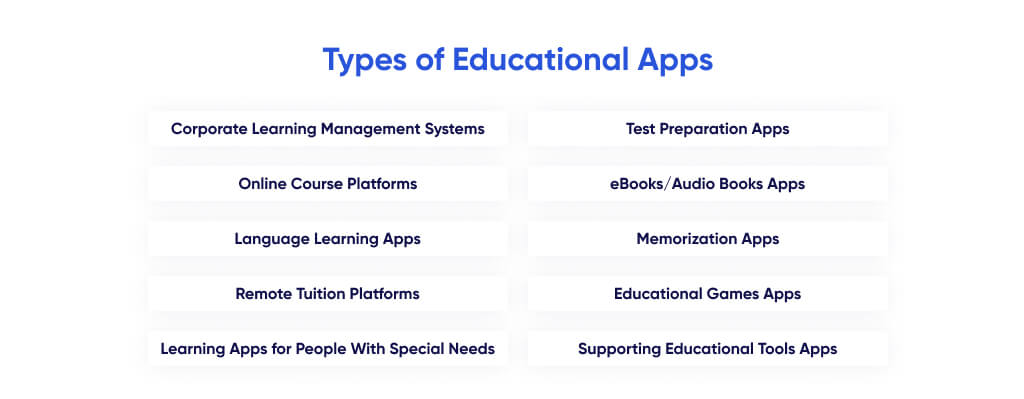
Corporate Learning Management Systems (LMS)
Let’s start with by far the most popular and fast-evolving type of eLearning software. The LMS.
What is it? A learning management system is on a more complex side of the spectrum when it comes to educational app development. This kind of app takes care of all the educational process elements, whether planning, creating necessary materials, actually conducting the programs, tracking progress, reporting, or billing.
The teachers and the students have access to it and can perform all the acquired tasks via a single platform. Depending on the organization’s needs, the custom LMS development process allows equipping the software with various types of functionality to cater to the users in the best way possible.
Why is it profitable? One of the greatest assets of an LMS is its multipurposeness. Where there’s a need for an apprenticeship, there’s an LMS. Learning management systems are equally common in educational facilities and commercial entities, which significantly expands marketing opportunities.
By investing in an LMS, the end users get a performance and efficiency boost, cut costs, and balance the workload. On the other hand, the vendor gets a vast market with new customers emerging almost daily.
Online Course Platforms
Some of the biggest names on the eLearning market are online course platforms loved and used by millions of people.
What is it? Online course platforms grant the users access to educational materials that make it easier to obtain new knowledge and practical skills. Unlike software used by facilities, where all the info depends on the pre-approved program, course platforms provide the audience with freedom of choice. One can learn how to speak a new language, code, cook, draw, edit videos, or master another skill of their choice.
Why is it profitable? People are looking for additional education opportunities for various reasons. It can be a stagnant career, a captivating ad, and even the promise to stick to New Year’s resolution.
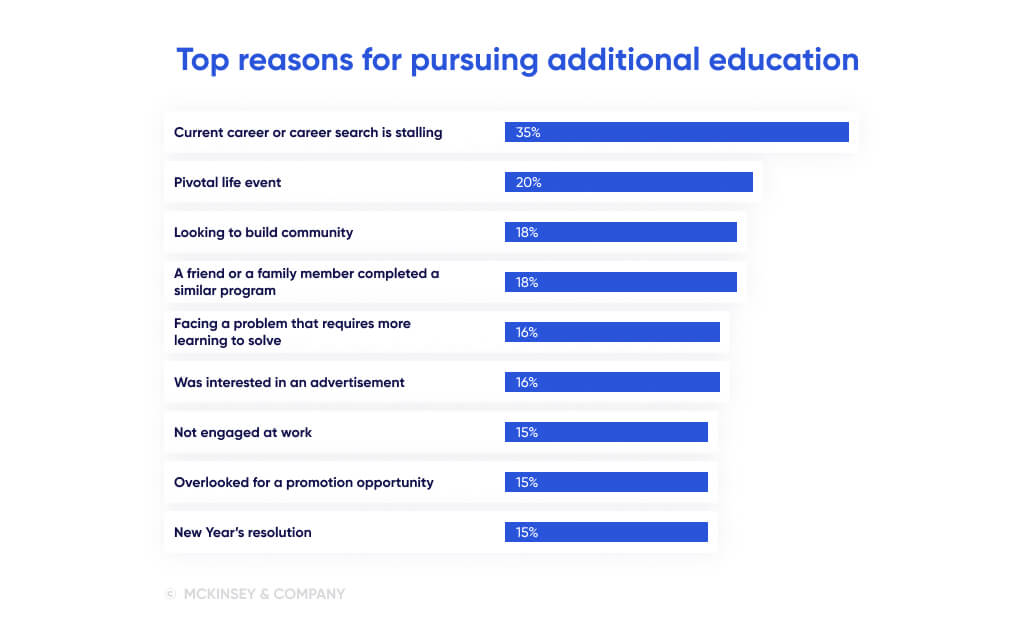
Clearly, there’s a growing demand for accessible digital solutions that offer structured and useful material on popular topics. People are willing to invest their time, attention, and money into platforms like that. This means that if executed well, online course platforms can become a goldmine for the owners. That’s why more entrepreneurs are willing to take a chance and build an educational app like that.
Language Learning Apps
Learn a new language on your own for free? Who wouldn’t want that?
What is it? Though the functionality of language learning apps may vary, in all of them, the user is given an opportunity to learn and practice a certain language by means of the digital product.
Why is it profitable? We live in a global world, and the ability to cooperate with people who have different cultural backgrounds is a key to success and personal growth. Ergo, the number of people who would like to expand their horizons by learning a new language will not diminish. On the contrary, it will grow. And so will your target audience if you decide to create an educational app that helps people learn languages.
Remote Tuition Platforms
Not a clone of LMS, though!
What is it? A remote tuition platform is an application that unites tutors and people who require tuition. It can be a marketplace where tutors create profiles, and the students choose the right fit for themselves. It can be a communication platform (for example, via video) that simplifies the educational process. It can be a non-profit social project where the tutors will be able to provide their services to people that simply can’t afford them. The list goes on!
Why is it profitable? We want to learn online. A new generation has already grown up with the idea of education services being available online 24/7. So being an online tutor is no longer a side hustle. It’s a full-time job that requires functional digital tools. No wonder entrepreneurs are willing to make an educational app and sell those tools!
Learning apps for people with special needs
An overlooked but essential type of eLearning software.
What is it? People who suffer from all kinds of disabilities or life-limiting conditions have been stripped of their right to learn for years. Modern technology calls a halt to it. Special needs software is designed and developed to simplify the educational process for teachers and students. Some of the examples include Sounding Board, Otsimo, or SymbolSupport.
Why is it profitable? This type of application isn’t always profitable. Still, this kind of software needs to be made and distributed.
Test Preparation Apps
Standardized tests and exams come every year. And students require sources that can help them prepare.
What is it? This group of apps is one of the most robust as it includes dozens of different types of software. Planners, organizers, trackers, quizzes, tests, mind-mappers, and much more! Some of the apps in this category (like My Study Life or GradeUp) combine multiple features and offer an all-in-one experience.
Why is it profitable? Absolute freedom of choice and a constant market demand create perfect conditions for businesses that plan to develop an educational app of this type.
eBooks/Audiobooks Apps
A popular trend that works perfectly for online education.
What is it? Themed audiobooks and podcasts are in high demand among people exploring all the opportunities of eLearning. Such apps typically offer a variety of audio material on a specific topic like language learning, IT, design, and many others.
Why is it profitable? A themed eBooks/audiobooks app attracts a specific audience with a certain request. It makes targetting easier and ads integration becomes more effective.
Memorization apps
A useful tool appreciated by many.
What is it? These applications simplify the process of memorization for the users. It can be virtually anything: formulas, new words in a foreign language, grammatical rules, etc.
Why is it profitable? Memorization takes time, and once the user downloads this kind of app and finds it effective, they visit the app regularly. So audience retention won’t be a problem.
Educational Games Apps
Technology brings fun to the education process!
What is it? Applications that manage to combine all the benefits of learning something new with the entertainment of gaming win the audience's hearts faster. Learning apps for children, educational games for teens, or challenge-based eLearning apps for adults. There are many ways to make an educational app that includes gaming elements.
Why is it profitable? Gamification is one of the hottest tech trends for a reason. Educational games are popular among users of all ages. If there’s an opportunity to make an educational process less dull, people will gladly use it. And if done right, a gaming app has all the chances to become a new market sensation.
Supporting Educational Tools
Applications that do not educate the user directly but help to make the process easier.
What is it? Think about all the apps that are aimed to help someone who is studying. Digital notepads, schedulers, messengers, calculators, and presentation builders. The list is nearly endless.
Why is it profitable? There are so many niches for business owners willing to build a unique app of that sort that the process of entering the market can be much easier compared to other types of eLearning software.
Is it a good time to create an educational app? Global market overview
One of the first things an entrepreneur takes into account prior to launching a new project or creating a new product is the state of the market. Analyzing specific signals makes it easier not to miss the moment when the market becomes oversaturated and the need for a certain solution decreases.
So what about the global eLearning market in 2023? Is it still worth time and money to create an educational app? Or maybe, considering a great number of different kinds of applications the development process is not worth the trouble?
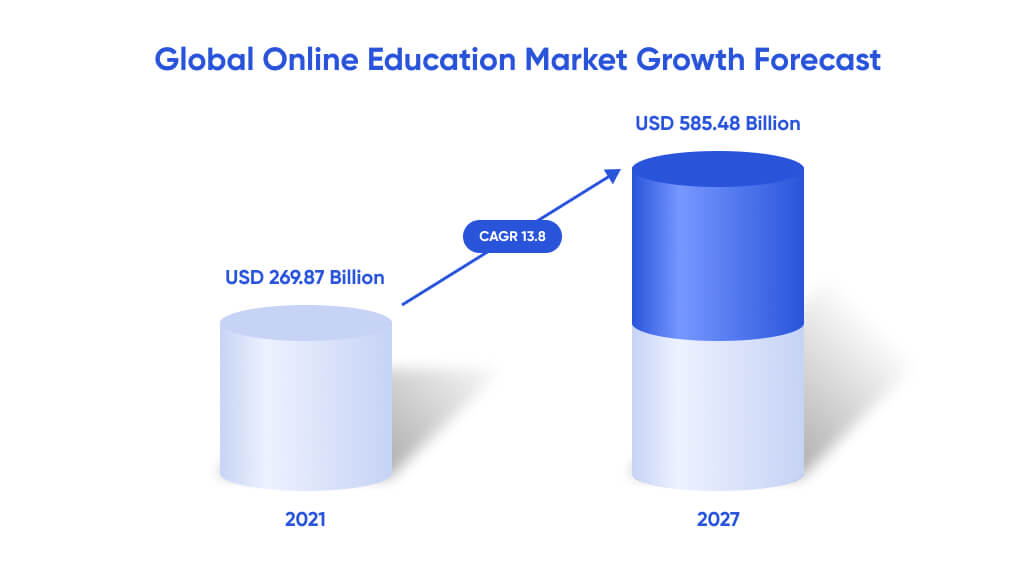
As a study by Renub Research shows, up to 2027, the international eLearning market will grow with a CAGR of 13.8% and will reach USD 585.48 billion by the end of the forecasted period.
Another important aspect many unintentionally neglect is the educational services accessibility. As much as we’d like to think that in 2023 almost all children in the world are going to school, it’s just not happening.
For various reasons, around 8% of primary school-age children do not attend educational facilities. This problem is more common in regions like Sub-Sharan Africa and South Asia, yet even in Europe and North America, there are thousands of children who have no access to basic education.
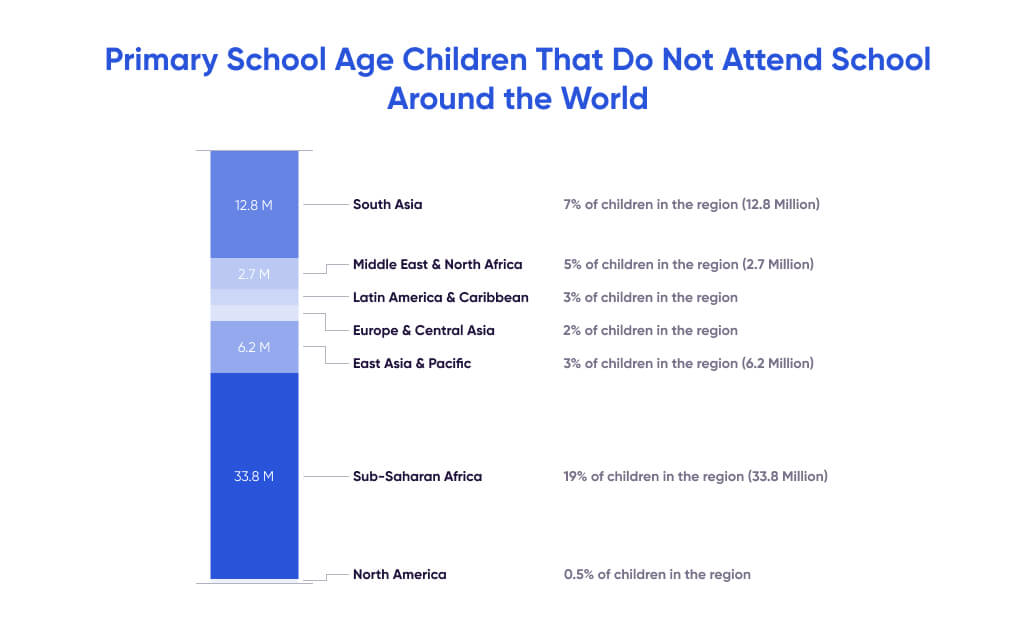
Moreover, even today, 1 in 10 adults doesn’t know how to read and write. The rapid development of eLearning technology may and will fix that.
As you can see, 2023 and several upcoming years will be the best time to create an educational app.
Choosing the right monetization strategy for an educational app
So now that you know about the situation in the eLearning market and all kinds of apps, it is time to think about another crucial aspect — product monetization.
We will cover the six most effective strategies that will help an application make money.
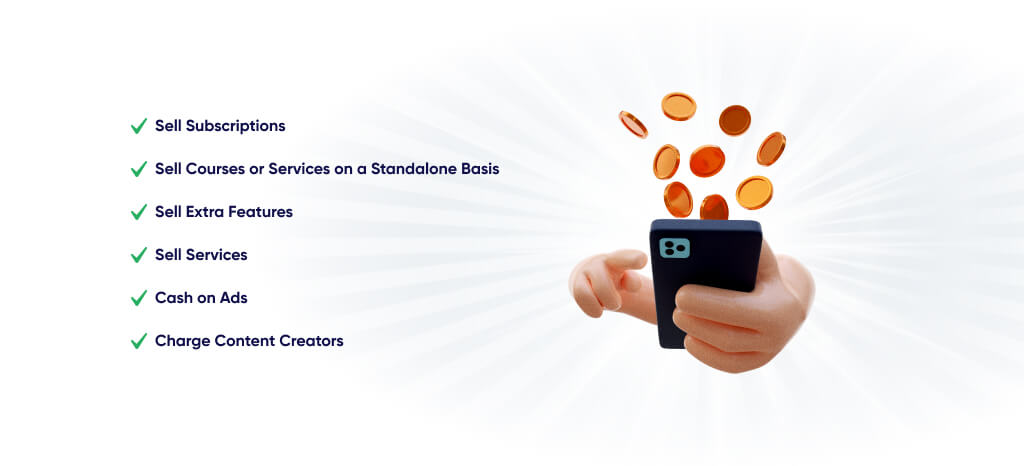
- Subscriptions. This one is easy and popular. Build an educational app and grant access to the product by charging regular payments. Usually, modern platforms offer several types of subscriptions: monthly, quarterly, and yearly. Yet, it’s up to the business owner which kind of subscription to include.
- Courses/Services sale. Instead of selling access to all of the app’s functionality, you may sell each of the available services or courses individually.
- Freemium. This model implies that the app offers basic functionality for free and sells additional features. It is a common strategy for larger platforms that would like to obtain a greater audience as people are more willing to choose a free app over a paid one (even if the payment is absolutely minimum).
- Sell services. This model is perfect for those who are wondering how to start an online school and profit off of it. Service sales is a monetization strategy for you if you’re a teacher or an online tutor who wants to create an educational app to get a digital platform for work.
- Ads. What if you plan to develop completely free software? Do you give up on monetization? Not at all! You just cash on ads! It is very beneficial as free access allows to maximize the audience.
- Charge content creators. If you are planning to have any third-party creators who will fill your app with content like original courses or who will sell their services, charge them and not the end users. A small percentage from each sale will ensure a stable income.
Keep in mind that it’s always possible to combine several strategies in one app. For example, you may develop an online course platform and sell subscriptions. At the same time, you can make money off of ads.
How to develop an educational app? A step-by-step algorithm
Educational app development is complex. Yet, it can easily be broken down into seven simple steps anyone can follow. Let’s review them all!
Determine your offer
First and foremost, you need to decide what your software is going to offer the general public. What are you going to sell or provide? If you don’t have a clear vision yet, revisit this article's “most common types of educational apps” section and pick the one you find the most attractive from a business perspective.
Keep in mind that it’s not enough to just decide on the software’s type. You also need to find that special something that will make people download and use your app. There is room for newcomers in the global educational market. However, there also are some powerful, trusted brands, and you need to find a way to steal the audience’s attention to win.
Study your audience
Digital eLearning products can be catered to almost anyone. Babies and adults, men and women, rich and poor alike, we all need to learn and grow. That’s why determining and than studying the target audience is so important.
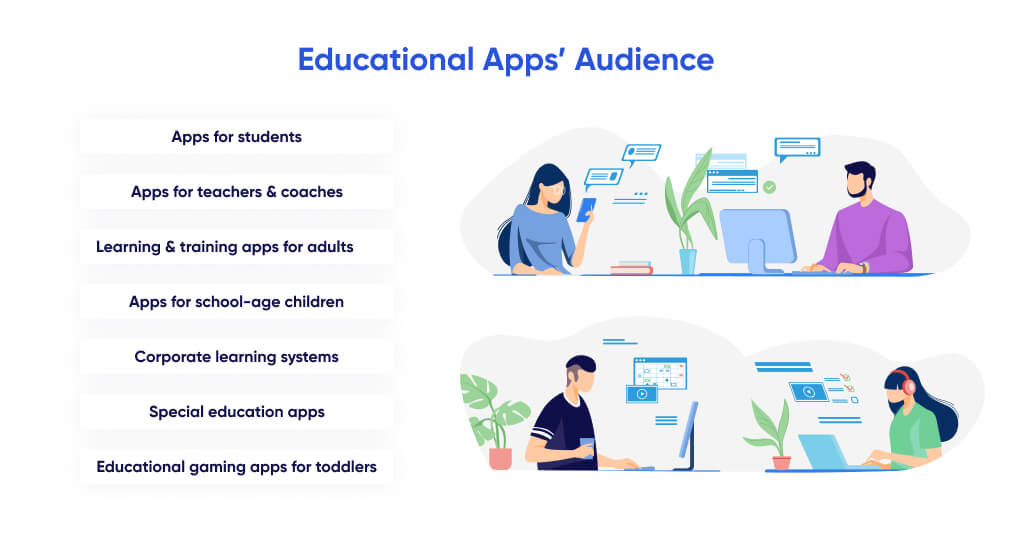
School-age children and their parents will obviously imagine a good educational app differently. They’d be willing to see different functionality, design, gamification elements, and training material delivery. To hit the bull's eye and earn the audience’s loyalty, you need to determine all of the possible needs and wants and satisfy those within a single application.
Do the research
This is a step an entrepreneur can do on their own or hire professionals to do it for them. It sometimes happens that even the most brilliant idea is not welcomed by the audience. So there’s always a risk of creating a great functional application no one wants.
Thorough market research prevents that from happening. Possible competitors, market demand, latest trends, audience’s pain points… All of this and much more should be taken into consideration during the research. Once this stage is over, the business owner might face the need to make slight alterations to the future application or even reconsider the software’s concept entirely. And that is not a reason to give up on educational app development, as these possible changes will be the key to future success.
Plan on functionality
Turning the “dreamer mode” on is highly recommended at this stage. Think about all the features you want your product to include. Write your thoughts down. The list you will get at the end will be of great use to the tech team (once you choose one).
Don’t be afraid to include “too many” features, as this step is not the time to edit. Later, during the educational app development process, IT professionals may possibly narrow it down a bit or offer alternatives. As for now, dream big and think about a perfect app you want to create.
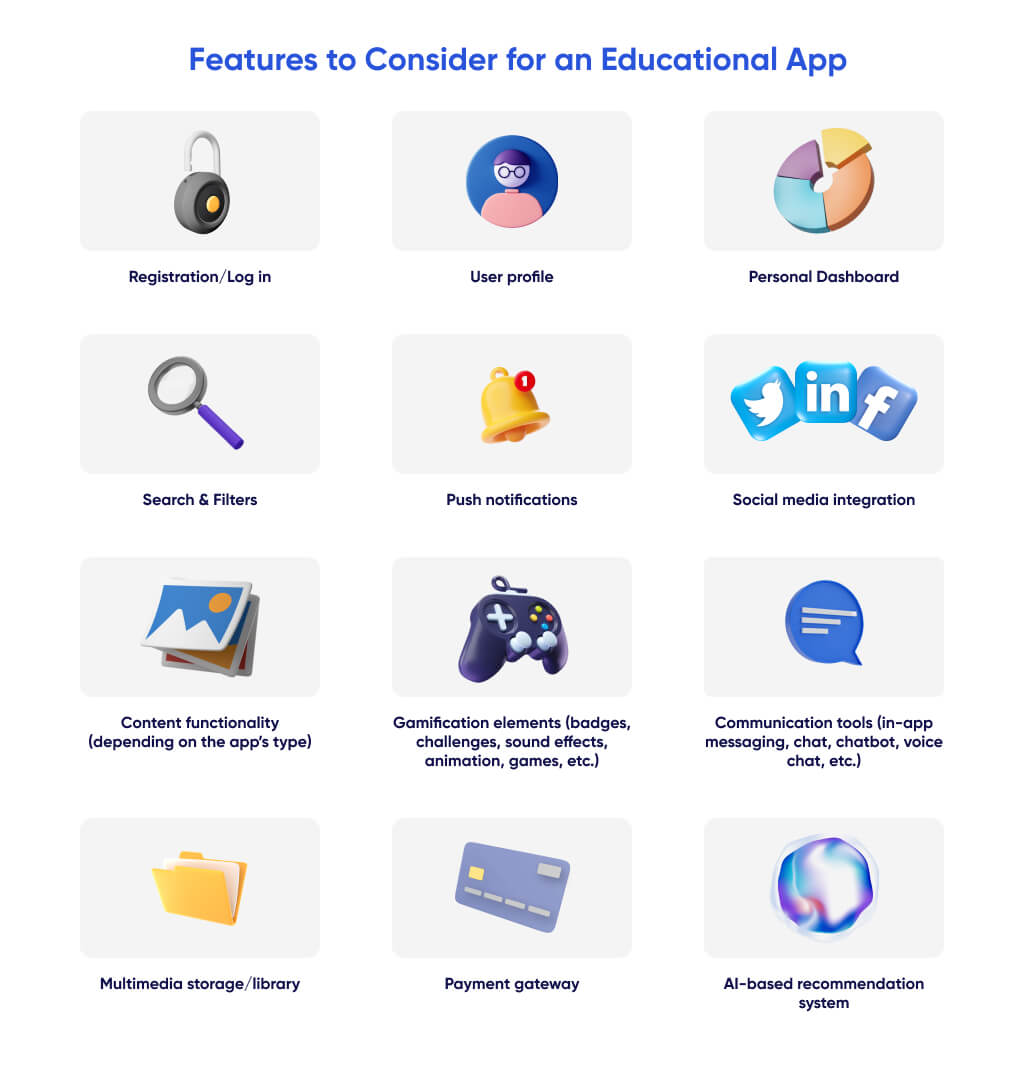
App Store and Google Play are perfect for drawing inspiration in this regard. Check out the comment sections of the apps similar to yours. What do users want? What makes them unhappy? Learning from the mistakes of your competitors is always smart.
Pick the platform
One of the several technology-based choices an entrepreneur has to make if they’re willing to create an educational app. The business owner should decide whether to build a web app, a mobile app, or both.
Regarding mobile development, there’s another choice: build separate native products for iOS & Android or make a single app that will work on all devices.
The choice made at this stage is important as it will have a direct influence on the development time and cost, plus an indirect influence on the functionality.
Note that you can postpone the decision and make it final only after the discussion with a chosen IT provider.
Choose the IT vendor
Tech contractor selection might take some time, and it is important not to rush it. A modern entrepreneur is offered numerous ways to find a trustworthy IT provider that will bring high-quality services without charging all the money in the world for it.
Here are only a few options to consider:
- B2B directories
- Online marketplaces
- Edtech & eLearning-themed events
- Word of mouth
What’s even more important, a business owner is not obligated to choose a team from their country. Thanks to nearshoring and offshoring, it is possible to cooperate with IT professionals from all over the world and even assemble an international team if you desire.
Develop, launch, and support
Once the IT provider has been chosen and all the papers have been successfully signed, tech gurus will take care of the development process and launch, which you’ll only have to supervise.
The moment it is over, and the apps are available for the audience to enjoy, it is time to track the user’s feedback, make changes (if necessary) and take care of the post-launch application support.
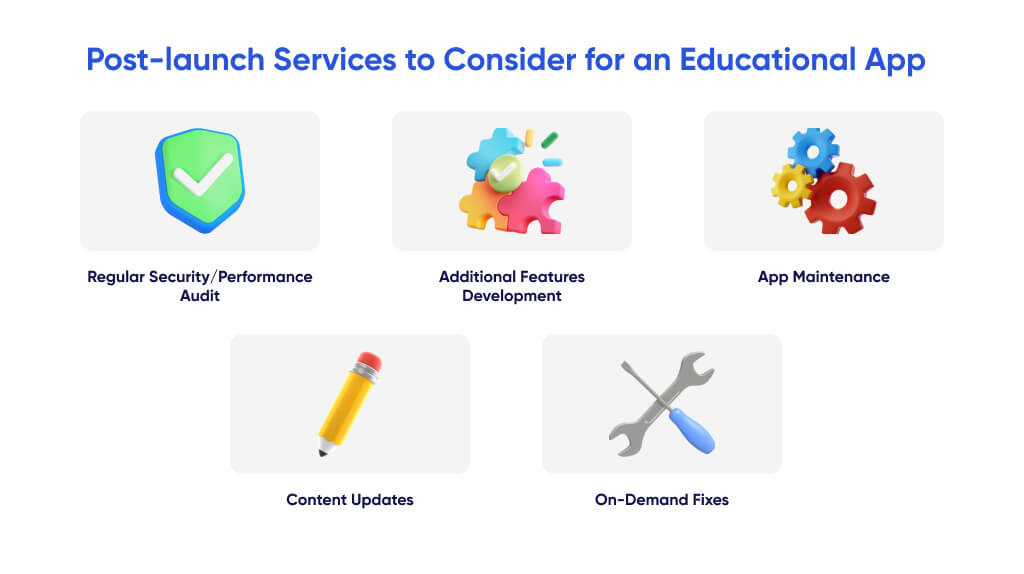
The thing is, many entrepreneurs forget that each app requires post-launch maintenance like regular updates, security checks, and more. Discuss post-launch support with your vendor to ensure the application’s smooth functioning and users’ satisfaction.
How much does educational app development cost?
It won’t be a stretch to say that the matter of cost is one of the few things that can stop the business owner from application development. Is it actually that expensive, and how much will you have to spend to make an educational app? Get all the questions answered in this section!
The development price of any software is determined by a combination of multiple factors. And that is the reason why entrepreneurs may receive drastically different estimations for the same project from different software development teams.
What are those factors? The list includes but is not limited to the following:
- Your and the development team’s location
- App’s complexity (technologies and number of features)
- Chosen platform
- Client’s needs and expectations
Now let’s examine how the price may change depending on the aspects listed above.
Location plays a major role in determining the app development cost as the price of IT services isn’t the same in every country. Web and mobile developers in the US, Canada, Australia, and Northern and Western Europe have higher rates than their peers in Eastern Europe, the Middle East, Africa, or Asia.
Just compare average hourly rates in the US (USD 100-150) and Ukraine (USD 25-35). As you can see, Ukrainian experts charge x4 times less.
Software’s complexity is another point you should consider if you need to build an educational app while not overshooting the budget. The matter of complexity includes not only the number of features that will make it to the app's final version. It also implies the business owner should be aware that the tech stack also influences the price.
For example, nowadays, it is common to incorporate artificial intelligence and machine learning in education apps. AI/ML experts have higher rates than other developers. Consequently, the total cost will be higher as well.
Yet again, the number of chosen features forms the price and the development timeline. Such feature-packed apps as learning management systems will require a bigger budget and up to 2000+ hours of development. While simpler software like Audiobook apps or MVP implementation will take significantly less time (500-750 hours) and less money.
A preferred platform will change the app’s price the same way a tech stack will. As a rule of thumb, iOS developers charge more than web developers or Android pros. Cross-platform solutions cost less than native.
For example, you need to build an educational app with a mobile version only. If you opt for native app development, you will end up with two separate applications for iOS and Android. However, if you choose cross-platform app development and hire a tech guru specializing in Flutter, you will get a single app that works both on iOS and Android devices. If the budget is tight, go for a cross-platform solution. It will take less time and will cost approximately 30% less than two native apps.
The client’s needs and expectations play a major role in determining the final cost of a digital product. Some may need to develop an educational app that is an exact copy of an already existing software. The others are willing to create an application from scratch. Some will provide the vendor with the designs. The others will expect an all-inclusive service. Each case is different, and so is the price. The best way to find out the cost is to ask for an estimation. A respected, trustworthy IT agency will create a ballpark estimation document for free.
eLearning Market Leaders Who Are They? Most Successful Educational Apps in 2023
To build an educational app that will be the best, you have to learn from the best. So who rules the eLearning app market in 2023, and what does it take to be successful and loved by the audience?
A report by Similarweb gives a pretty decent overview of the market leaders in different corners of the world. What’s interesting, the top 100, for the major part, stay the same no matter which country you choose. Apps like Duolingo, Canvas, Babbel, Coursera, Quizlet, ClassDojo will be on top of the list.

So what makes good eLearning software, and how to develop an educational app that will become the next Udemy, PBS Kids Games, or Rosetta Stone?
- Most apps you will see among the most popular are either completely free or utilize a freemium monetization model. Even the smallest fee and lack of free content will scare off the audience.
- Successful apps incorporate gamification. Challenges, leaderboards, badges, or straight-up educational gaming apps attract more users.
- Multifunctionality is an important aspect as well. The most popular apps always develop, grow, and change, adding new features per users’ requests. Consider this as a “golden standard.” Even if you plan to create an educational app that will be extremely specific and sleek, there’s always a way to make it more appealing to the user. Even the slightest changes like social media integration or a chatbot will increase the audience’s interest and engagement and will pay off in the long run.
Light IT Global’s Expertise
eLearning and Edtech solutions development has always been one of our company's key areas of expertise. With 15+ years of experience under the belt, Light IT Global can help you with bringing the following solutions to life:
- Learning management systems of any complexity
- Online educational portals & upskilling platforms
- Educational marketplaces
- Knowledge sharing platforms
- AI/ML-based interactive educational solutions
- Authoring systems & tutorial software
- Simulation programs
- Special needs software
- Virtual classrooms
- Skills measurement solutions
- …and more!
Light IT Global offers end-to-end custom software development services. This approach ensures maximum efficiency and offers a number of benefits to the customer.

So if you’d like to create an educational app but don’t know where to start, reach out, and our experts will help you!
Final words
eLearning software will continue to remain one of the major factors boosting the development process of the development of the global education industry. New tech trends will arise, making digital educational tools even more immersive, helpful, and affordable. To neglect this tendency now and not make an educational app that will find its place on the market means to lose a perfect moment and give up a life-changing opportunity.
Don’t miss your chance to create a successful eLearning brand and create a product that will help thousands of people around the world! Contact Light IT Global team and get the high-quality digital product your business deserves!




